Are tiny, buzzing insects taking over your kitchen? You might be dealing with fruit flies, a common household nuisance. Fortunately, eliminating these pests doesn’t require expensive solutions or harsh chemicals. You can often find everything you need right in your pantry to create effective fruit fly traps. Like many homeowners, we recently encountered a fruit fly issue and decided to put various remedies to the test. After careful experimentation and observation, we’re sharing the most successful DIY fruit fly traps and actionable prevention strategies.
These homemade traps are not only simple to assemble but also utilize natural, readily available ingredients. They represent a budget-friendly and chemical-free approach to pest control. For those who prefer a humane solution, some of these traps even allow for releasing the captured fruit flies outdoors. Beyond traps, we’ll also cover essential tips to prevent fruit fly infestations from occurring in the first place.
Understanding Fruit Flies
Fruit flies are small flying insects that are drawn to ripe and fermenting fruits and vegetables, as their name implies. They are also attracted to sugary substances like juice, beer, and wine. You’ll often find them congregating around fruit bowls, garbage disposals, and even drains. Visually, they are tiny, about the size of a grain of rice, and resemble small, tan or brownish houseflies with distinctive red eyes. Fruit flies are most prevalent during warmer months when fruits are abundant.
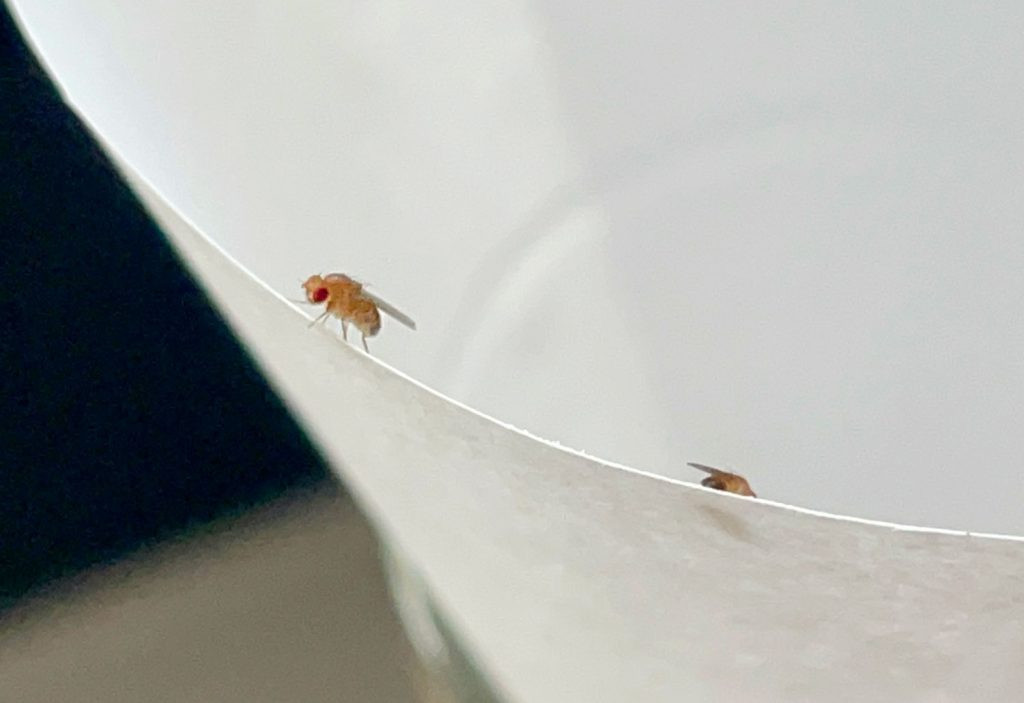 Close Up Of Fruit Fly On Paper Funnel
Close Up Of Fruit Fly On Paper Funnel
A fruit fly infestation can begin with just a few flies brought indoors on fruits or vegetables. However, female fruit flies can lay hundreds of eggs, which hatch in as little as 24 hours. They can complete their life cycle in a week, leading to rapid population growth. This rapid reproduction rate highlights the importance of prompt action to eliminate fruit flies.
Distinguishing Fruit Flies from Similar Pests
It’s easy to confuse fruit flies with other small flying insects commonly found in homes, particularly fungus gnats and drain flies. Accurate identification is crucial for choosing the most effective elimination method. The easiest way to differentiate them is by observing their appearance and preferred locations:
- Fruit Flies: Resemble miniature flies. Found near fruit bowls, garbage cans, and food sources.
- Drain Flies: Look like small, fuzzy moths. Typically seen near sinks and drains.
- Fungus Gnats: Resemble tiny mosquitoes. Usually found around houseplants, breeding in moist soil.
If you’re uncertain, trying one of the traps described below can help identify the pest. If the trap attracts the insects, you’re likely dealing with fruit flies.
Four Simple DIY Fruit Fly Traps
Getting rid of fruit flies doesn’t have to be a complicated or expensive endeavor. With basic household items and a bit of patience, you can create effective traps. The fundamental principle of each trap is to attract the fruit flies and then prevent their escape. We tested four popular DIY methods and identified a clear standout. Since each method uses common household items, experimenting with multiple traps is easy. Consider yourself a fruit fly scientist – it can be surprisingly engaging! Here are four DIY fruit fly traps we tested:
- Funnel Trap
- Plastic Wrap Trap
- Dish Soap Trap
- Rotting Fruit Trap
Below, we provide detailed instructions for each method and our findings. Keep in mind that some traps work faster than others, and complete eradication may take a few days.
1. The Paper Funnel Fruit Fly Trap
This trap design lures fruit flies into a container through a narrow opening at the base of a paper funnel. Once inside, the flies struggle to navigate back out through the small opening.
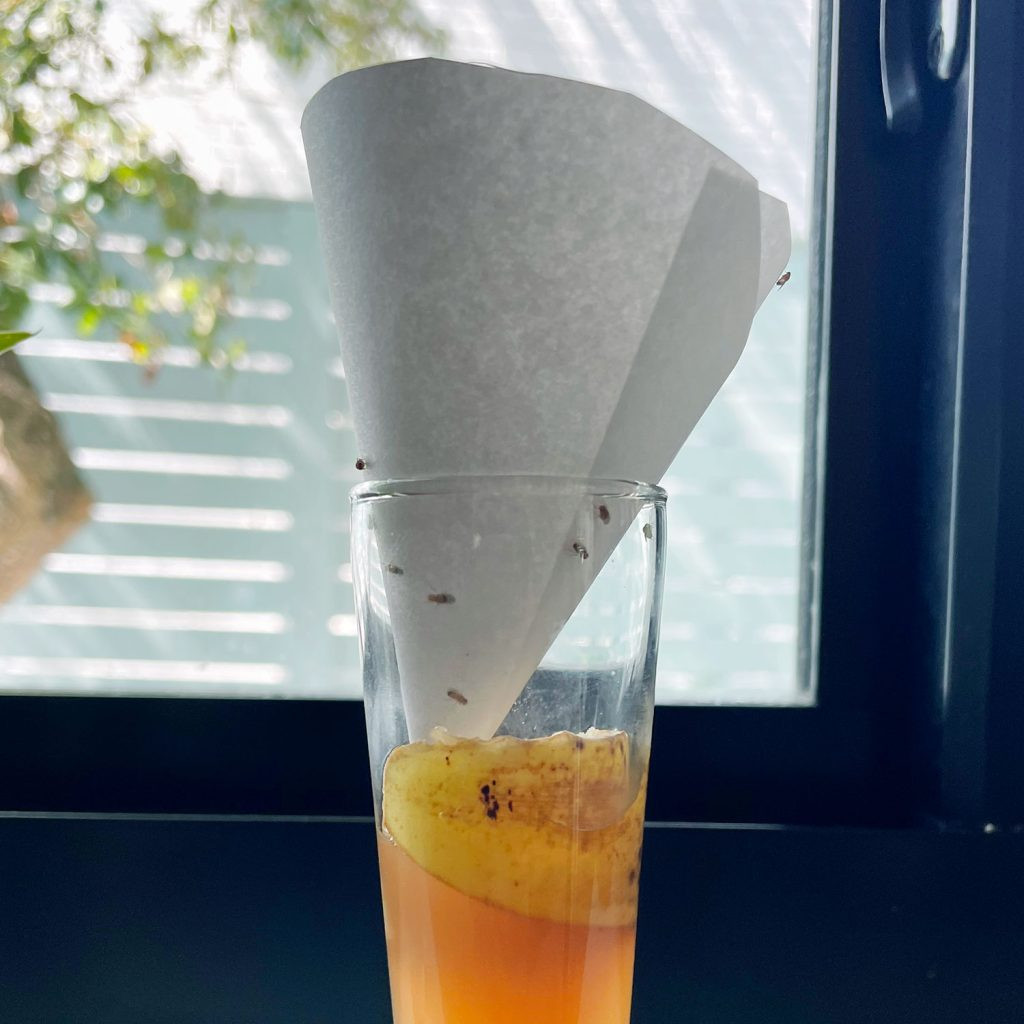 DIY Fruit Fly Trap With Paper Funnel
DIY Fruit Fly Trap With Paper Funnel
Supplies:
- Small, clear jar, cup, or container (narrow opening preferred)
- Piece of paper or cardstock
- Tape
- Scissors
- Apple cider vinegar (ACV)
Instructions:
- Select a container: Choose a small, clear container like a repurposed food jar or plastic bottle. A narrow opening enhances trap effectiveness.
- Add apple cider vinegar: Pour a small amount of apple cider vinegar, old beer, or wine into the container’s bottom. These liquids’ scents are highly attractive to fruit flies.
- Create a paper funnel: Shape a piece of paper or cardstock into a cone with a very small hole at the tip. Secure the cone shape with tape. You can create the small opening by cutting the tip after forming the cone. The opening should be approximately the size of a grain of rice.
- Position the funnel: Place the paper funnel into the container opening. Adjust the funnel’s width to rest securely on the container’s rim without touching the liquid. Ensure a snug fit to prevent fly escapes.
- Humane release (optional): To release trapped flies, carefully carry the trap outdoors without disturbing the funnel. Remove the funnel to allow the fruit flies to fly away.
While a store-bought funnel can be used, its opening might be too large, allowing captured flies to escape.
2. The Plastic Wrap Fruit Fly Trap
Similar to the funnel trap, this method uses apple cider vinegar to attract fruit flies. They enter through tiny holes poked in plastic wrap stretched over the container opening but struggle to find their way out.
Supplies:
- Small, clear jar, cup, or container
- Rubber band
- Plastic wrap or plastic bag
- Toothpick
- Apple cider vinegar (ACV)
Instructions:
- Choose a container: Select a small, clear jar, cup, or similar container. Clarity helps monitor trap effectiveness, but opaque containers like soda or beer cans also work.
- Add apple cider vinegar: Pour apple cider vinegar into the container. Its scent acts as the primary attractant. Old beer or wine can also be used, but avoid regular white vinegar.
- Cover with plastic wrap: Tightly stretch plastic wrap over the container opening and secure it with a rubber band. Saran wrap is ideal, but plastic bag scraps can also work.
- Puncture small holes: Use a toothpick to create a few small holes in the plastic wrap. The holes should be large enough for fruit flies to enter but not too large for easy escape.
- Humane release (optional): To release captured flies, carefully move the trap outdoors without removing the plastic wrap. Remove the plastic wrap to allow the flies to fly away.
Alternatively, you can use a jar lid. Puncture a hole in a metal jar lid using a hammer and nail for a reusable trap cover.
3. The Dish Soap Fruit Fly Trap
This trap method, unlike the previous two, doesn’t require a cover. Instead, it utilizes dish soap to disrupt the surface tension of the liquid, trapping the flies. Note: This method is not suitable for humane release as the soap coats the flies.
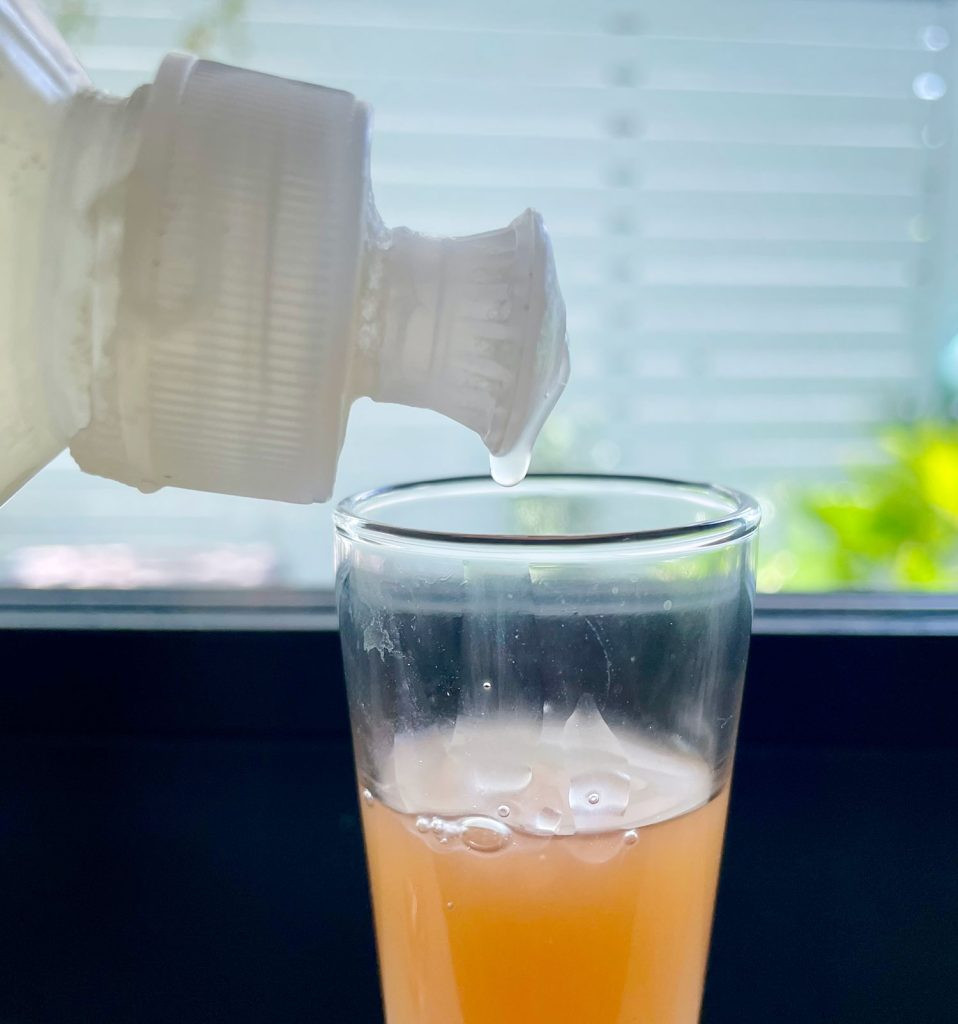 Dripping Dish Soap Into Apple Cider Vinegar For DIY Fruit Fly Trap
Dripping Dish Soap Into Apple Cider Vinegar For DIY Fruit Fly Trap
Supplies:
- Small container, bowl, or dish
- Dish soap
- Apple cider vinegar (ACV)
Instructions:
- Pour apple cider vinegar: Fill the bottom of a small container, bowl, or dish with apple cider vinegar. The scent will attract fruit flies.
- Add dish soap: Add several drops of dish soap to the apple cider vinegar and gently mix. The soap breaks the surface tension, causing flies to sink when they land.
This dish soap technique can also be combined with the funnel or plastic wrap traps for enhanced effectiveness. Adding soap to the apple cider vinegar before covering the trap provides an additional trapping mechanism.
4. The Rotting Fruit Fruit Fly Trap
Fruit flies are naturally drawn to overripe fruit. This trap method leverages this attraction by using actual fruit as bait instead of apple cider vinegar.
Supplies:
- Small glass jar, cup, or container
- Plastic wrap or paper funnel (depending on chosen trap style)
- Small piece of ripe fruit (banana peel or apple slice)
To create a rotting fruit trap, simply replace the apple cider vinegar in either the plastic wrap or funnel trap with a piece of banana peel, apple slice, or peach. You can also enhance the attractant by adding a fruit scrap to apple cider vinegar. However, be sure to replace the fruit every day or two to prevent unpleasant odors.
Determining the Best Fruit Fly Trap
We tested these four DIY traps side-by-side to evaluate their effectiveness. Our test included:
- Plastic Wrap Trap with banana peel
- Funnel Trap with ACV + banana peel
- Plastic Wrap Trap with ACV + dish soap
- Dish Soap Trap with ACV
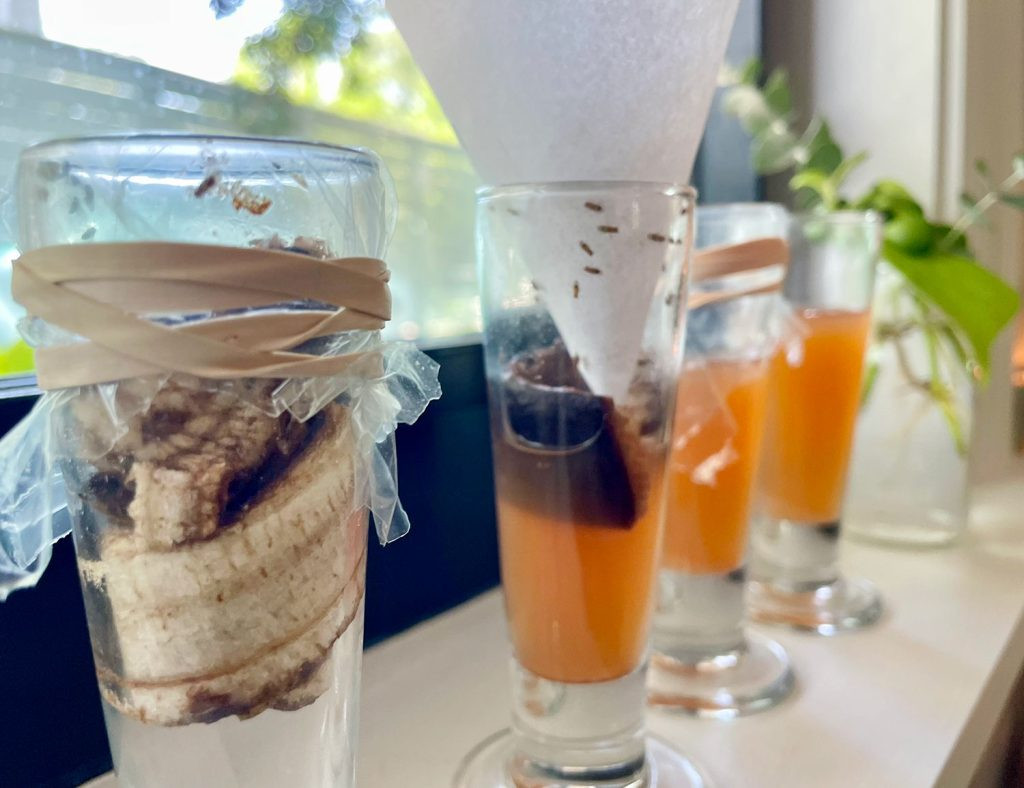 4 DIY Fruit Fly Traps Close Up
4 DIY Fruit Fly Traps Close Up
Our results indicated that the type of bait was more critical than the trap design. Traps using banana peel significantly outperformed those using only apple cider vinegar. The plastic wrap traps were very similar in design, but the banana peel trap captured far more flies than the ACV and soap trap. It seems real fruit is a more potent attractant than apple cider vinegar alone, especially when fruit is readily available.
Therefore, we recommend incorporating a piece of fruit into any fruit fly trap you choose. We slightly preferred the plastic wrap trap due to its simplicity and stability. The funnel trap was accidentally knocked over once, releasing some trapped flies.
Identifying the Most Effective Fruit Fly Attractant
Intrigued by the success of fruit scraps, we further investigated which type of fruit was the most effective bait. We tested three readily available fruits: banana peel, apple slices, and strawberry, using plastic wrap traps for each.
While the banana peel initially seemed promising due to its strong odor, the strawberry proved to be the most attractive bait over 24 hours. The banana peel still captured a good number of flies, but the strawberry’s effectiveness increased as it ripened further. Surprisingly, the apple slices attracted almost no fruit flies.
Store-Bought Fruit Fly Trap Options
If DIY traps aren’t providing satisfactory results or if you prefer a ready-made solution, several effective store-bought fruit fly traps are available. These traps often have excellent customer reviews and are generally priced under $20. They might be a worthwhile option if you want to trap various flying insects or prefer a more discreet trap design.
 Collage of Storebought Fruit Fly Traps
Collage of Storebought Fruit Fly Traps
During our experiment, we purchased Terro Fruit Fly Traps to compare their performance to our homemade traps. We placed a Terro trap alongside our banana and strawberry traps for 24 hours.
Again, the homemade strawberry trap performed best, closely followed by the banana peel trap. The store-bought trap initially caught only one fruit fly. However…
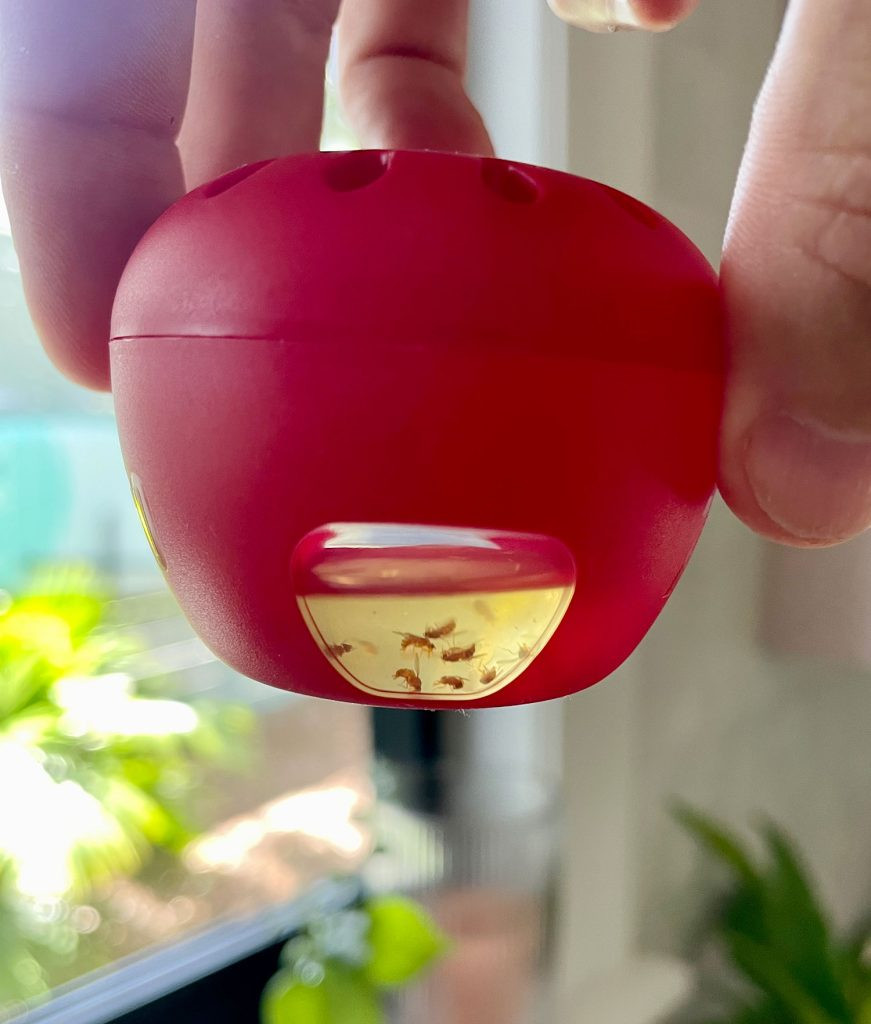 Terro Fruit Fly Trap With Dead Fruit Flies Visible
Terro Fruit Fly Trap With Dead Fruit Flies Visible
To ensure a fair comparison, we removed the DIY traps and left the store-bought trap for another 24 hours. Over this extended period, the Terro trap captured a significant number of fruit flies, as shown above. While effective, it was not as rapid or initially as efficient as our homemade traps. Store-bought traps are a good choice for a less conspicuous, longer-term solution, but homemade traps offer a faster initial reduction in fruit fly populations.
Preventing Fruit Fly Infestations
While eliminating fruit flies is relatively straightforward, preventing them from establishing themselves in your home is even better. Here are simple preventative measures:
- Maintain clean kitchen surfaces: Regularly wipe down countertops, stovetops, tables, and any surfaces that might collect food residue or spills. Fruit flies are particularly attracted to fruit, sugary liquids, and alcohol, so promptly clean up any spills.
- Dispose of trash regularly: Food scraps left in garbage cans, especially overnight, can quickly become fruit fly breeding grounds. Empty trash cans frequently, particularly kitchen trash.
- Manage ripe fruit: Monitor fruit bowls for overripe or decaying fruits like bananas and apples. Dispose of them promptly before they attract fruit flies.
- Wash produce immediately: Washing fruits and vegetables as soon as you bring them home from the grocery store can remove any fruit fly eggs or larvae that may be present. (Note: Berries are an exception as washing can accelerate spoilage).
- Refrigerate produce: Fruit flies don’t thrive in cold environments. When possible, store fruits and vegetables in the refrigerator to deter them.
- Clean sink drains: Food particles accumulating in sink drains can attract fruit flies. Regularly run the garbage disposal and flush drains with hot water or a drain cleaner.
Finally, remember that discovering fruit flies in your home is common and manageable. While prompt action is advisable to prevent a larger infestation, the solutions outlined are simple, effective, and fast-acting. You might even find the process of creating and testing fruit fly traps a surprisingly engaging and educational experience.